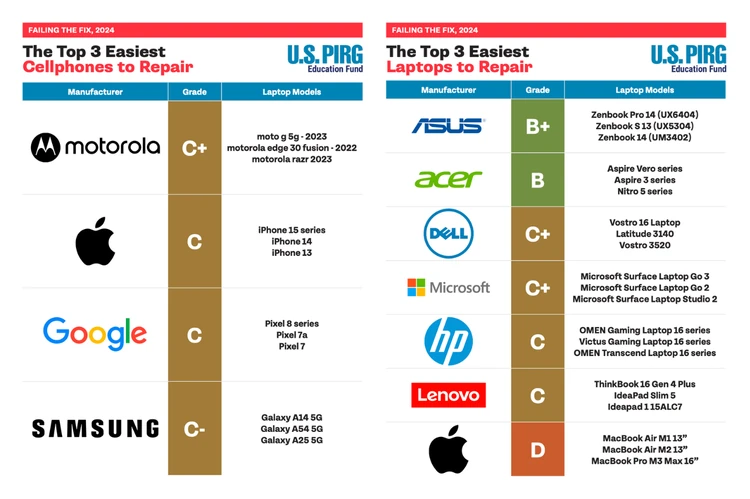Let's admit it – cell phones and computers are crucial for nearly every aspect of our life, from work and education to communication and entertainment.
With personal devices becoming essential purchases, the question of affordability extends beyond the initial cost. When these vital electronics break, consumer advocates say consumers shouldn't be forced to replace them due to high repair costs or intentional design barriers.
We may be preaching to the choir here, but a new report from U.S. PIRG Education Fund suggests that many tech companies prioritize planned obsolescence by making their products difficult to repair, pushing consumers towards expensive replacements.
To address this issue, the PIRG released its annual "Failing the Fix" scorecard, evaluating the repairability of popular cell phone and laptop brands.
PIRG’s scorecard considered several factors. Among them:
Does the manufacturer provide free service manual information to consumers?
How easy is it to open and repair the device? Case in point, Apple products.
Is it easy to find replacement parts?
Are spare parts affordable?
Companies that do the right thing are rewarded
The organization suggests that companies that prioritize long-lasting and easily repairable designs will be rewarded with customer loyalty, while those that force consumers into unnecessary replacements could be shooting themselves in the foot.
The scorecard also identifies the top repairable options within each brand, empowering consumers to make informed choices that benefit both their wallets and the environment.
“When consumers buy tech products, they deserve to know whether they can repair their device and make it last,” said Lucas Gutterman, U.S. PIRG Education Fund’s Designed to Last campaign director and author of the report.
“You don’t always get what you pay for – at least when it comes to repairability. People should be able to buy products from companies that respect our Right to Repair [such as Colorado recently implemented] and ensure that their devices work for a long time.”
Failing grades all the way around
Consumers should be able to count on Big Tech getting the message from these studies, but that doesn’t seem to be the case. No tech company got a grade higher than a B+ and a couple of notable trends from last year’s study continued into 2024.
For example, Google’s Chromebooks – one of the more budget-friendly options on the market – continue to be less repairable than other manufacturers' laptops. Macbook lovers may swear by their machines, but Apple continues to be in last place for laptop repairs.
Overall in the cell phone department, Motorola leads cell phone manufacturers with a C+, while Apple improved a bit and it and Google are tied for second place, each earning a C. Samsung lags with a C-.
For laptop manufacturers, ASUS leads in repairability with a B+, followed by Acer with a B, then DELL and Microsoft tie for third each scoring a C+ grade, HP and Lenovo follow each earning a C, and Apple is in last place with a D.

“Repair scorecards provide vital information for consumers to make informed decisions when purchasing personal devices,” Gutterman said.
“Charging hundreds of dollars for disposable technology is ridiculous and unfair to those who buy these products. If a phone or laptop can be fixed and used for years, it offers more long-term value. Companies should do more to ensure their products are designed to last, and lawmakers should pass Right to Repair bills that entrench our ability to fix our stuff.”
Photo Credit: Consumer Affairs News Department Images
Posted: 2024-02-11 16:37:59



















